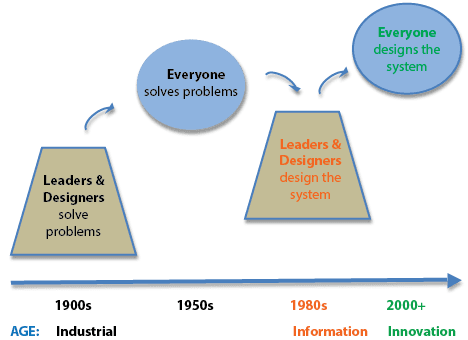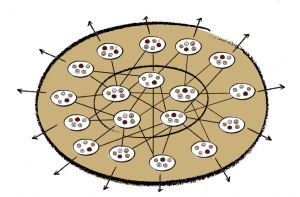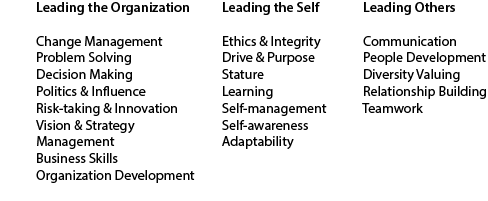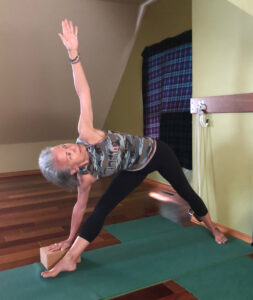No matter what our occupation or where we reside, how we currently live and work is being redefined by global trends such as:
• information and communication technological advances
• demographic changes in a highly educated workforce
• economic shifts
• complex demands in business for simultaneous improvement and innovation
• climate change
These trends are also revolutionizing society’s ethical expectations, particularly of business behaviour. Trust is increasingly becoming the new currency of every transaction and relationship, which further impacts every organization’s need to generate that trust. The consequence for business, and possibly the greatest impact yet to emerge fully, is the impact on leadership.
From my perspective, we are witnessing a radical transformation not only in how we view but also in how we initiate change. As enactors of change, individuals, corporations and nations are coming to terms with understanding the importance of adapting to rather than manipulating our living environments. Furthermore, we recognize our collective responsibility for our present conditions as well as our individual accountability for creating a healthy, humane future.
In the world of work, the shifting paradigm of leadership is evolving beyond authority roles into the competencies required for greater social and economic contribution. These competencies are increasingly being expected of all employees regardless of front-line or executive responsibilities. Although this revolution of trust-building and shared leadership is yet to become mainstream (the New Normal), we continue to witness the redesign of organizations from leader-led to leader-full environments. When we experience a leader-full workplace, we recognize leadership as a system, an architectural element of an organization, in which we design the governance or coordination processes best suited to optimize its strategies and structure as well as society at large.
This blog attempts to briefly portray the emerging experience of leadership in its many shifting facets and to synthesize my estimate as to how enterprises will continue to adapt in order to survive and thrive in an age of tremendous innovation, complexity and turbulence.
From Manipulation to Adaptation. In two recent conversations with social entrepreneurs, of which I include myself, we lamented the challenge of doing business in an economic environment where surviving is yet to be balanced with thriving. The survival game amounts to business entrepreneurs and leaders manipulating the physical environment (geographic, political, social and economic) to optimize profit and return. In other words, business emphasizes making money often to the exclusion of the health and well being of humanity and the planet.
Thriving, on the other hand, constitutes a holistic and integrated approach to jointly optimizing potentials (geographic, political, social and economic) with profit being only one of many measures of success. With the added complexity of merging the needs of these multiple requirements, business strategies valuing competition and manipulation are giving way to collaboration and adaptation. So, you might ask, why the lamenting on our part? . . . because my entrepreneurial friends and I are products of our era and as such learned how to profit under the old economic regime. In order to thrive in today’s business environment, we are unlearning the old survival skills as well as internalizing the new social enterprise skills of collaboration and adaptation.
From Role & Control to Responsibility & Competency. In an Innovation Age (see image below) where the only constant is change, it is not surprising our ever-evolving work and workplaces are accompanied by radical transformation in the roles of both organization leaders and organization designers.

In an organization design book, I am currently co-authoring with six North American practitioners, we uncover three emerging ‘leadership’ truths worth sharing.
- We are all designers. Co-existence in organizational life amounts to collectively designing happy healthy innovative communities of work for positive social change.
- We are all co-designing SIMULTANEOUSLY at multiple levels of interaction and complexity — VICO, VIDO, VRN and IBES. Designing a whole system amounts to designing interactions (coordinating mechanisms) within an organization and between it and its many different networks of collaborators — suppliers, partners, customers, etc.
- We are all leaders. Co-designing happy healthy innovative communities of work for positive social change amounts to unleashing initiative, imagination and passion across the entire system’s network.
As we discovered within our own changing role as organizational designers, the expert and authority-based model of designing and leading change is no longer effective for the New Normal circumstances of the Innovation Age. Collectively, organizations need to catalyze creativity from as diverse a pool of talent as possible.
Although a multitude of leadership competency models exist in the marketplace, and I list only one below, the majority contain most of these components.
Society for HR Management Leadership Competencies:
From Competencies to Contribution & Collaboration. In moving through the Industrial and Information Ages, global society lived within the tension of restructuring from centralized to decentralized organization structures. The Innovation Age’s added complexities include decentralized structures composed of teams (see image below) to better handle what emerged in the market place — more competition, more workflows (products and/or services) and more uncertainty. These decentralized structures look more like interconnected networks than organizations with concrete boundaries. Their boundaries are organized around complete pieces of work, not around functions/silos, and their teams are multi-functional with several roles existing within each team.

As Niels Pflaeging states in his 2014 book, Organize for Complexity, the existing need for stable processes and innovation demands we collaboratively design organizations to navigate the amount of uncertainty confronting us. Just as we can no longer leave organizational decision-making and leadership to a few managers, we must distribute organizational design knowledge, skills and decisions throughout the entire organization. In decentralized (adaptive and innovative) organizations, everyone needs to be continuously redesigning the system to align it with the continuously changing external environment of customer expectations and market demands.
As our society grows and matures so does the degree of complexity confronting us on a daily basis. In times of complexity and rapid change, we need to integrate every bit of intelligence available (emotional, social, intellectual, spiritual, economic, political, etc.) to both stabilize our existing foundations and innovate new responses to new challenges.
From Leader-led or Leader-less to Leader-full. The next milestone on the leadership learning curve is to cultivate leadership within each person on the planet. When we bring all of humanity into the dance, we create a social tipping point whereby a critical mass of humanity sharing similar vision (i.e., a desire to build happy, healthy, humane organizations and communities) shifts mass consciousness. Just as a virus can go epidemic, humanity is witnessing and waiting for the tipping point where adaptive leader-full organizations go viral. As Malcolm Gladwell (Outliers; Tipping Point) proffers, with one action practiced over 10,000 hours, anyone of us can create an epidemic.
Nonetheless, it may still be impossible to predict what will tip the leadership scales as exemplified by Occupy Wall Street, which grew from a bunch of ‘kids’ sleeping in Zuccotti Park to an international movement. Their legacy included introducing the language of the 1% and 99%; an illustration of chaordic organizing and the exemplification of “leader-full” (versus leader-led or leader-less) decision processes.
What leadership strengths do you contribute no matter what you are doing? What other leadership skills can you cultivate in your life to work to bring us closer to the tipping point?






